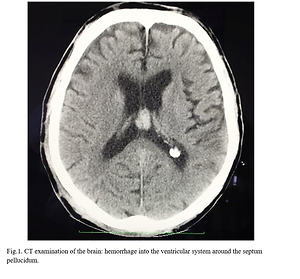Online first
Current issue
Archive
Special Issues
About the Journal
Publication Ethics
Anti-Plagiarism system
Instructions for Authors
Instructions for Reviewers
Editorial Board
Editorial Office
Contact
Reviewers
All Reviewers
2025
2024
2023
2022
2021
2020
2019
2018
2017
2016
General Data Protection Regulation (RODO)
CASE REPORT
An epileptic seizure and haemorrhage into the ventricular system of the brain as the first
manifestations of acquired haemophilia A – Case report
1
Department of Haematooncology and Bone Marrow Transplantation, Medical University, Lublin, Poland
2
Department of Neurosurgery and Pediatric Neurosurgery, Medical University, Lublin, Poland
Corresponding author
Adrian Juda
Department of Haematooncology and Bone Marrow Transplantation, Medical University in Lublin, Aleje Racławickie 1, 20-059, Lublin, Poland
Department of Haematooncology and Bone Marrow Transplantation, Medical University in Lublin, Aleje Racławickie 1, 20-059, Lublin, Poland
Ann Agric Environ Med. 2021;28(3):531-533
KEYWORDS
TOPICS
ABSTRACT
Acquired haemophilia (AH) is a suddenly occurring severe blood diathesis that affects both males and females and is caused by autoantibodies which inhibit coagulation factor VIII. The report describes an unusual case of acquired haemophilia in which an epileptic seizure and haemorrhage into the ventricular system of the brain were the first manifestations of the disease. In addition, APTT was prolonged to 94.6 seconds and the factor VIII level was as low as 1.5%. The level of anti-FVIII antibody was extremely high – 272BU/ml. The patient did not undergo invasive diagnostic procedure or an operation. Recombinant factor VIIa was used to control the bleeding. In order to eradicate the inhibitor, the patient received prednisone and cyclophosphamide. Complete remission was achieved after 5.5 weeks of treatment.
REFERENCES (12)
1.
Windyga J, Baran B, Odnoczko E, et al. Treatment guidelines for acquired haemophilia A.Ginekol Pol. 2019; 90(6): 353–364. doi: 10.5603/GP.2019.0063.
2.
Charlebois J, Rivard GE, Str-Louis J. Management of acquired haemophilia A: Review of current evidence. Transfus Apher Sci. 2018; 57(6): 717–720. doi: 10.1016/j.transci.2018.10.011.
3.
Akamatsu Y, Hayashi T, Yamamoto J, et al. Newly diagnosed acquired haemophilia A manifesting as massive intracranial hemorrhage following a neurosurgical procedure. World Neurosurg. 2018; 111: 175–180. doi: 10.1016/j.wneu.2017.12.016.
4.
Sehara Y, Hayashi Y, Mimuro J. Acquired Haemophilia A with a rare presentation of acute subdural hematoma. Case Rep Neurol Med. 2015 2015: 543927. doi: 10.1155/2015/543927.
5.
Garcia-Chavez J, Majluf-Cruz A. Acquired haemophilia. Gac Med Mex. 2020; 156(1): 67–77. doi: 10.24875/GGM.19005469.
6.
Lan Mo, George C. Bao. Acquired factor VIII deficiency: two case report and a review of literature. Exp Hematol Oncol. 2017; 6(1): 8–8. doi: 10.1186/s40164-017-0068-3.
7.
Franchini M, Glingani C, De Donno G, et al. The first case of acquired haemophilia A associated with SARS-CoV-2 infection. Am J Hematol. 2020; 10.1002/ajh.25865. doi: 10.1002/ajh.25865.
8.
Mingot-Castellano ME, Nunez R, Rodriguez-Martorell FJ. Acquired haemophilia: Epidemiology, clinical presentation, diagnosis and treatment. Med Clin (Barc). 2017; 148(7): 314–322. doi: 10.1016/j.medcli.2016.11.030.
9.
Tsuyama N, Ichiba T, Naito H. Unusual Initial Manifestation of Acquired Haemophilia A: A normal Activated Partial Thromboplastin Time, intramuscular hematoma and cerebral hemorrhage. Intern Med. 2016; 55 (22): 3347–3349. doi: 10.2169/internalmedicine.55.7219.
10.
Mashiko R, Yamamoto T, Sato M, et al. A. Acquired haemophilia first manifesting as life-threatening intracranial hemorrhage-case report. Neurol Med Chir. 2009; 49: 93–95. doi: 10.2176/nmc.49.93.
11.
Bonnaud I, Saudeau D, de Toffol B, Autret A. Recurrence of spontaneous subdural haematoma revealing acquired haemophilia. Eur Neurol. 2003; 49(4): 253–254. doi: 10.1159/000070200.
12.
Marquardt L, Haubelt H, Gass S, et al. Intracranial bleeding in acquired haemophilia. Nervenarzt. 2006; 77(12): 1480–1482. doi: 10.1007/s00115-006-2181-0.
We process personal data collected when visiting the website. The function of obtaining information about users and their behavior is carried out by voluntarily entered information in forms and saving cookies in end devices. Data, including cookies, are used to provide services, improve the user experience and to analyze the traffic in accordance with the Privacy policy. Data are also collected and processed by Google Analytics tool (more).
You can change cookies settings in your browser. Restricted use of cookies in the browser configuration may affect some functionalities of the website.
You can change cookies settings in your browser. Restricted use of cookies in the browser configuration may affect some functionalities of the website.



